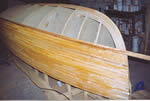| All the
comments and descriptions above are very brief but the following basic
conclusions can be drawn from them :-
1. For first time
builders with few wood working skills and a shallow purse, stitch and
tape is the construction method to choose - also if the amount of time
you can put to the build is low, then again, this is the method to go
for.
2. If you want a
lightweight car-toppable boat, again, stitch and tape is the method to
choose although if you have good wood working skills or are willing to
learn and do not mind spending the extra on good quality materials,
modern clinker ply and strip planked Cedar also produce light hulls.
3. If you are only
looking at plywood for the main construction material then for boats
over 20' (6.1m) in length, l tend to use ply over frame construction -
this method gives you a rigid framework and point of reference to work
too - joins in the hull skin panels usually have a wood stringer behind
them rather than tape and epoxy. I have used stitch and tape for some
quite large craft but fighting with plywood panels longer than 20' of
3/8" or 1/2" (9mm or 12mm) thickness and trying to get them
stitched together in the correct place without a reference framework can
be very frustrating unless you have lots of hands to hold the panels in
place. The amount of epoxy used in stitch and tape boats over 20' (6.1m)
also tends to be large and never seems to want to stay where l put it!
Modern frameworks tend to be of egg-box plywood construction rather than
the old fashioned solid wood affairs with few, if any redundant members
- a well designed ply over frame hull will have ply bulkheads and
girders slotted together with these components forming bunk and locker
fronts and partitions.
4. A modern strip
planked hull which is veneered or coated in glass/epoxy on the outside
is, effectively, a single monocoque shell which does not leak and which
requires less framing and will last - it also gives the appearance of a
conventional round bilge carvel planks hull without all the
disadvantages - building skills required are not too high so, if you
have the time and the additional funds, this is an excellent
construction method.
5. Clinker ply is
also a very effective way of producing a beautiful monocoque shell - it
takes more skill, better and more extensive tools and more funds - but
it has been used by plenty of first time builders who have been prepared
to gain the skills and use the good reference manuals available for this
method,
6. Also consider
resale values - a nicely built strip planked or clinker/ply hull will
retain there values and become an investment. Stitch and tape hulls also
retain a good value but will not have the same resale value.
7. If you are
considering building a bigger boat which, no matter which construction
method you use, will require a bigger investment in time, money etc and
you have not built before, consider building a smaller boat (ie. a
dinghy to be used as a tender for the bigger boat) which uses the same
method of construction, first. |




